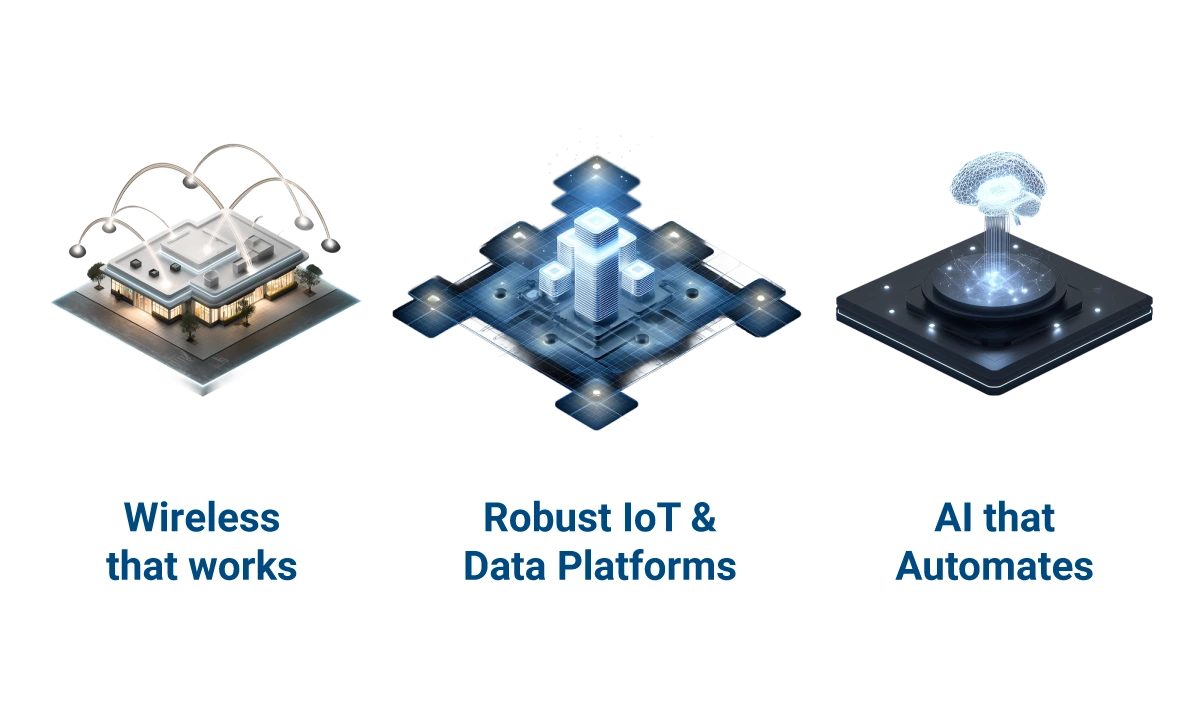
For decades, smart building technology has focused on large facilities such as office towers, hospitals, airports, and campuses—leaving smaller buildings behind. As we explored in our earlier blogs, “Thermostats Don’t Scale Up” and “Building Automation Systems Don’t Scale Down,” the solutions available to light commercial buildings have always existed at opposite extremes. Traditional building automation systems are too costly, complex, and IT-intensive to deploy at scale, while residential-style smart thermostats are too limited to manage multi-unit commercial spaces effectively.
That dynamic is finally changing. The convergence of three key technologies—1) wireless communication that finally works, 2) cloud-native platforms with edge intelligence, and 3) artificial intelligence—is redefining what is possible for light commercial buildings under 50,000 square feet. Together, these advances make it practical, affordable, and scalable to bring true smart building capabilities to the 5.5 million light commercial buildings that have long been overlooked.
Wireless technology that simply works has removed the installation, networking, and reliability barriers that once kept smart building technologies out of reach for smaller facilities.
LoRaWAN provides long-range, low-power communication that penetrates walls, ceilings, and concrete. It enables battery-powered sensors to operate for up to five years, collecting data from mechanical rooms, rooftops, walk-in coolers, and occupied spaces without pulling a single wire.
At the same time, LTE and 5G networks now provide nearly universal coverage, allowing building hubs to connect automatically to the cloud without relying on local Wi-Fi or IT networks. This ensures always-on connectivity, eliminates security hurdles, and removes the need for firewalls, passwords, or configuration support from local staff.
Cloud-native architectures with IoT support make it possible to deliver advanced capabilities at light commercial scale.
Traditional building automation required local servers, custom programming, and network integration, an approach that simply does not scale down to the light commercial market.
Modern cloud-native data platforms have changed that equation. Today, cloud IoT platforms make it possible to stream in large amounts of device data while cloud databases make it possible to cost-effectively store, manipulate, and retrieve data. These technologies can be used to ensure continuous operation on-site while providing centralized visibility and management across every location.
Cloud-native design also simplifies deployment and updates. Devices can be automatically provisioned, firmware updated over the air, and configurations replicated across portfolios. There is no need for manual programming or local commissioning.
AI transforms sensor data into actionable intelligence that delivers measurable ROI for operators and contractors alike.
Even the best wireless and cloud systems are only as valuable as the insights they produce. The final enabling technology is advanced artificial intelligence turning high-fidelity building data into actionable insights.
High-fidelity data from temperature, humidity, power, occupancy, and air-quality sensors enables algorithms to detect patterns that humans or thermostats cannot see. AI models can identify inefficiencies such as short-cycling compressors, drifting setpoints, or unbalanced zones that waste energy and shorten equipment life. Portfolio-level benchmarking reveals which sites or units are consuming the most energy or deviating from expected performance.
With AI-powered insights, facility, operations, and contractor teams can shift from reactive maintenance to data-driven, predictive operations that improve comfort and lower total cost of ownership.
These three technologies are converging to make what was once impossible, possible. Together, they bridge the long-standing gap between smart thermostats (that don’t scale up for light commercial) and building automation systems (that don’t scale down for light commercial). This convergence represents a fundamental shift in how small buildings can be connected, monitored, and managed.
UBX was built for this convergence. We are leveraging these technologies to build the first unified, scalable smart building platform specifically for light commercial buildings. Our solution delivers automatic energy savings, remote monitoring, and actionable insights. All without costly wiring, programming, or IT dependencies.
Talk with an expert to learn how UBX is helping operators modernize their portfolios and unlock the value of smarter, more connected buildings.